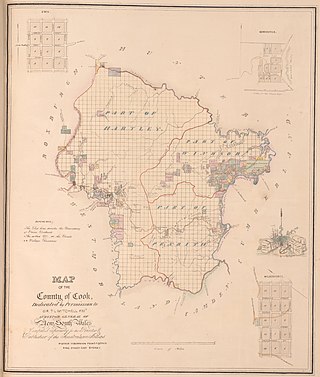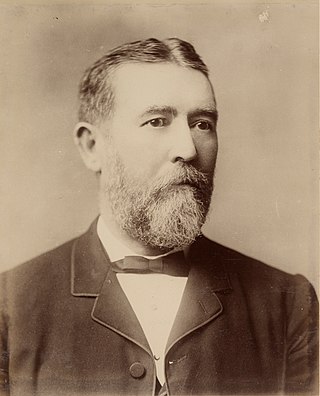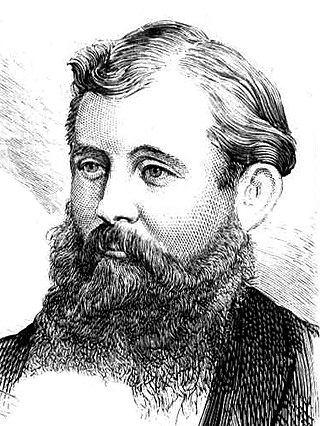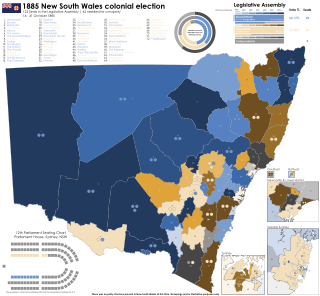
The New South Wales Legislative Assembly is the lower of the two houses of the Parliament of New South Wales, an Australian state. The upper house is the New South Wales Legislative Council. Both the Assembly and Council sit at Parliament House in the state capital, Sydney. The Assembly is presided over by the Speaker of the Legislative Assembly.

Sir James Martin, QC was three times Premier of New South Wales, and Chief Justice of New South Wales from 1873 to 1886.

Cook and Westmoreland was an electoral district of the Legislative Assembly in the Australian state of New South Wales in the first and second Parliaments (1856–1859), named after Cook and Westmoreland counties in the Blue Mountains, Lithgow and Oberon areas. It elected two members simultaneously, with voters casting two votes and the first two candidates being elected. It was largely replaced by Hartley, however both members moved to other electorates, James Martin became the member for East Sydney, while Robert Jamison became the member for Nepean.

Geoffrey Eagar was an accountant and colonial politician and civil servant in New South Wales, Australia.
Members of the New South Wales Legislative Assembly who served in the seventh parliament of New South Wales held their seats from 1872 to 1874. The 182 election was held between 13 February and 28 March 1872 with parliament first meeting on 30 April 1872. There were 72 members elected for 52 single member electorates, 6 two member electorates and 2 four member electorates. The maximum term of this parliament was 3 years. However the assembly was dissolved after 32 months. Henry Parkes was the premier for the duration of the parliament. The Speaker was William Arnold.

The third Robertson ministry was the fifteenth ministry of the Colony of New South Wales, and was led by John Robertson. It was the third of five occasions that Robertson was Premier. Robertson was elected in the first free elections for the New South Wales Legislative Assembly held in March 1856.
The second Parkes ministry was the sixteenth ministry of the Colony of New South Wales, and was led by Sir Henry Parkes. It was the second of five occasions that Parkes was Leader of the Government.

The third Parkes ministry was the nineteenth ministry of the Colony of New South Wales, and was led by Sir Henry Parkes in a coalition with Sir John Robertson. It was the third of five occasions that Parkes was Leader of the Government.

James Watson was an Australian politician, Colonial Treasurer of New South Wales 1878 to 1883.

John Bowie Wilson, often referred to as J. Bowie Wilson, was a politician, gold miner and hydropath in colonial New South Wales, a member of the New South Wales Legislative Assembly for more than 12 years.

Sir Robert Wisdom, was a politician in colonial New South Wales and Attorney General of New South Wales.

John Fitzgerald Burns was an Australian politician, member of the Parliament of New South Wales, Postmaster-General in the 1870s and Colonial Treasurer in the 1880s.

Sir John Lackey was a magistrate and politician in colonial New South Wales, President of the New South Wales Legislative Council 1892 to 1903.

The 1891 New South Wales colonial election was held in the then colony of New South Wales between 17 June to 3 July 1891. This election was for all of the 141 seats in the New South Wales Legislative Assembly and it was conducted in 35 single-member constituencies, 20 2-member constituencies, 10 3-member constituencies and nine 4-member constituencies, all with a first past the post system. Part 1 of the Electoral Act of 1880 set the qualification for election on "every male subject of Her Majesty of the full age of twenty-one years and absolutely free being a natural born or naturalized subject". Seven seats were uncontested. The previous parliament of New South Wales was dissolved on 6 June 1891 by the Governor, The Earl of Jersey, on the advice of the Premier, Sir Henry Parkes.

The 1885 New South Wales colonial election was held between 16 October and 31 October 1885. This election was for all of the 122 seats in the New South Wales Legislative Assembly and it was conducted in 37 single-member constituencies, 24 2-member constituencies, seven 3-member constituencies and four 4-member constituencies, all with a first past the post system. Suffrage was limited to adult male British subjects, resident in New South Wales. The previous parliament of New South Wales was dissolved on 7 October 1885 by the Governor, Lord Augustus Loftus, on the advice of the Premier, George Dibbs.

The 1864–65 New South Wales colonial election was held between 22 November 1864 and 10 January 1865. This election was for all of the 72 seats in the New South Wales Legislative Assembly and it was conducted in 52 single-member constituencies, six 2-member constituencies and two 4-member constituencies, all with a first past the post system. The previous parliament of New South Wales was dissolved on 10 November 1864 by the Governor, Sir John Young, on the advice of the Premier, James Martin. Suffrage was limited to adult white males.

The 1860 New South Wales colonial election was held between 6 December and 24 December 1860. This election was for all of the 72 seats in the New South Wales Legislative Assembly and it was conducted in 52 single-member constituencies, six 2-member constituencies and two 4-member constituencies, all with a first past the post system. Suffrage was limited to adult white males. This was the first election after the separation of Queensland in December 1859.

The 1859 New South Wales colonial election was held between 9 June and 7 July 1859. This election was for all of the 80 seats in the New South Wales Legislative Assembly and it was conducted in 58 single-member constituencies, seven 2-member constituencies and two 4-member constituencies, all with a first past the post system. Suffrage was limited to adult white males. The previous parliament of New South Wales was dissolved on 11 April 1859 by the Governor, Sir William Denison, on the advice of the Premier, Charles Cowper.
James Rodd was an English-born Australian politician.
West Sydney, an electoral district of the Legislative Assembly in the Australian state of New South Wales was created in 1859 and abolished in 1894.



















